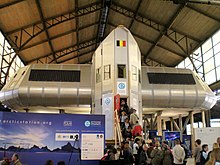Princess Elisabeth Antarctica

Princess Elisabeth Antarctica, located on Utsteinen Nunatak in Queen Maud Land (71°57′00″S 23°20′51″E / 71.949960°S 23.347503°E), is a Belgian scientific polar research station, which went into service on February 15, 2009. The station, designed, built and operated by the International Polar Foundation, is the first polar base that combines eco-friendly construction materials, clean and efficient energy use, optimization of the station's energy consumption and clever waste-management techniques.
The station is built against a ridge (The Utsteinen ridge) that is exposed to gales of up to 300 kilometres per hour (190 mph). The station can withstand such strong winds through its aerodynamic shape and its foundation anchoring of several metres deep into the permafrost. Philippe Samyn, a Belgian architect, was involved in designing the shell and underlying structure. The upper deck of the building is the actual station and looks over the ridge edge. The lower deck contains a garage for snowcat vehicles and other utilities.
The Princess Elisabeth base is the only zero-emission base on the Antarctic, and runs entirely on solar and wind energy through the use of a micro smart grid. The station is connected to nine wind turbines that stretch out along the Utsteinen ridge. It houses up to 16 scientists at a time.
The station is named after the Belgian princess Elisabeth, the eldest child and heir apparent of King Philippe.
See also
External links
- Belgian Antarctic Research Station - Princess Elisabeth Station
- International Polar Foundation
- Belgian Polar Platform
- The Princess Elisabeth Polar Station: a case study on Constructalia
- Zero-Emissions Station A slideshow about the Princess Elisabeth Station, Allianz Knowledge, July 2008
- COMNAP Antarctic Facilities
- COMNAP Antarctic Facilities Map
- The Pricess Elisabeth Station at Philippe Samyn and Partners
